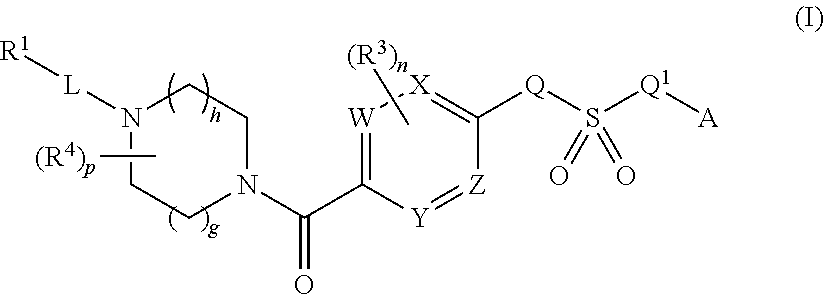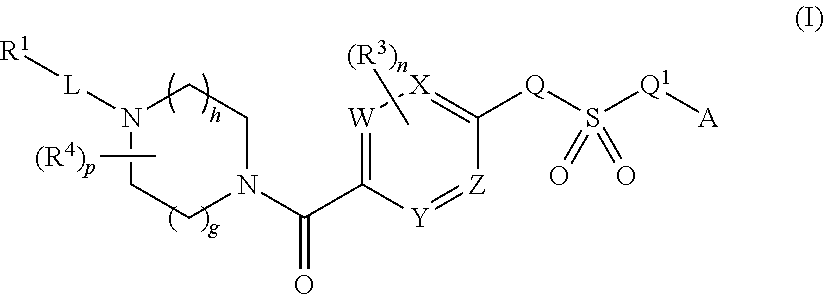Therapeutic compounds and compositions
a technology applied in the field of therapeutic compounds and compositions, can solve the problems of loss of allosteric control of pkm2, the necessary shunting biochemical intermediates, and the inability to exploit the therapeutic effect of pyruvate kinase function to achieve the effect of shunting, and achieve the effect of reducing the risk of pyruvate kinase activity and reducing the risk of pyruva
- Summary
- Abstract
- Description
- Claims
- Application Information
AI Technical Summary
Problems solved by technology
Method used
Image
Examples
example 1
Preparation of Compounds of Formula Ic
[0203]
wherein R1 is aryl or cyclopropyl; Rc is methyl or CF3; R3 is alkyl and n is 0 or 1.
[0204]Synthesis of Intermediate IV. To a stirred solution of aryl ketones II (17 mmol) in 10 ml of dichloromethane were added optionally substituted tert-butyl piperazine-1-carboxylate I (16 mmol), Et3N (48 mmol) and 1 M TiCl4 (8 mmol) at room temperature, followed by stirring the reaction mixture at room temperature for 18 h. To the reaction mixture was added a solution of NaBH3CN (48 mmol) in MeOH (5 ml) at room temperature, followed by stirring the reaction mixture at room temperature for 6 h. Ethyl acetate and saturated aqueous NaHCO3 solution were added to the reaction mixture. The insoluble material obtained was filtered off using celite. The ethyl acetate layer was separated, washed with brine, dried over anhydrous MgSO4 and filtered. The filtrate was concentrated in vacuum and the crude compound was taken for the next step without purification. The ...
example 2
Preparation of Compounds of Formula Id
[0257]
wherein R1 is cyclopropyl or aryl.
[0258]Synthesis of intermediate XI. A solution of Aryl / Cycloalkyl methyl ketone X (1.6 mmol) in dry THF (10 ml) was cooled to −70° C. in N2 atmosphere. Methylmagnesium bromide (8 mmol) in THF was added slowly at −70° C. and the reaction mixture stirred for 1 h under N2 atmosphere. The reaction mixture was quenched with saturated NH4Cl and diluted with Ethyl acetate (20 ml) and Brine (20 ml). The organic layer was washed with water, dried over Na2SO4, and evaporated under reduced pressure. The residue was purified by column chromatography (silica gel, 60-120 mesh; EA-Hexane, 2:8) to afford product XI as an oil in 60-72% yield.
[0259]Synthesis of intermediate XII. To a solution of Gemdimethyl alcohol XI (1.1 mmol) in dry DCM (10 ml) was added sodium azide (3.5 mmol) at room temperature under N2 atmosphere. The reaction mixture was cooled to 0° C. and was added a solution of TFA (3 mmol) in DCM (1 ml). The rea...
example 3
Preparation of Compounds of Formula Ie
[0279]
wherein Rd, when present, is aryl; R3 is methoxy or OCF3; and q is 1, 2, 3, or 4.
[0280]Synthesis of Intermediate XXII. To a stirred solution NaH (21 mmol) in DMF (10 ml) at 0° C. was added aryl acetonitrile XX (4.2 mmol) in DMF slowly and stirred for 15 minutes at the same temperature. Dibromoalkane (4.2 mmol, n=2, 3, 4, 5) in DMF (5 ml) followed by sodium iodide was added to reaction mixture and was heated to 120° C. for 4 h. After completion of reaction, mixture was diluted with water and extracted with EtOAc. The organic layer was washed with water, dried over Na2SO4, and evaporated under reduced pressure. The residue was purified by column chromatography (silica gel, 60-120 mesh; EA-Hexane, 1:9) to afford product XXII in 75-89% yield.
[0281]Synthesis of Intermediate XXIII. In a sealed tube a stirred solution of Nitrile XXII (3 mmol) in HCl (aqueous, 6 ml) was heated for 24 h at 100° C. After completion of the reaction the reaction mixtu...
PUM
 Login to View More
Login to View More Abstract
Description
Claims
Application Information
 Login to View More
Login to View More - R&D
- Intellectual Property
- Life Sciences
- Materials
- Tech Scout
- Unparalleled Data Quality
- Higher Quality Content
- 60% Fewer Hallucinations
Browse by: Latest US Patents, China's latest patents, Technical Efficacy Thesaurus, Application Domain, Technology Topic, Popular Technical Reports.
© 2025 PatSnap. All rights reserved.Legal|Privacy policy|Modern Slavery Act Transparency Statement|Sitemap|About US| Contact US: help@patsnap.com



